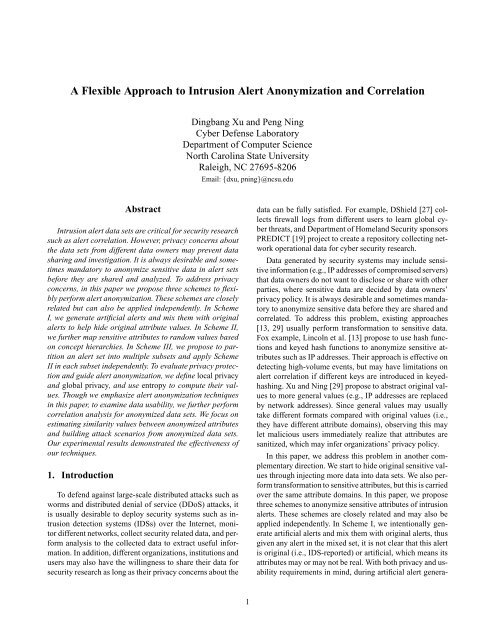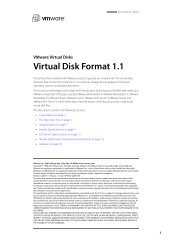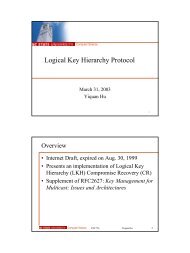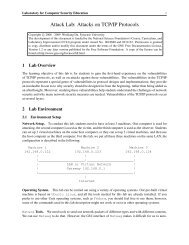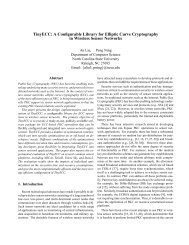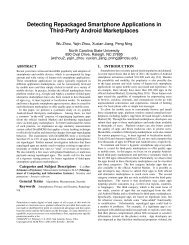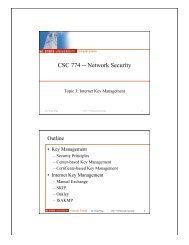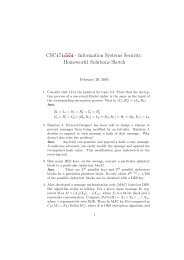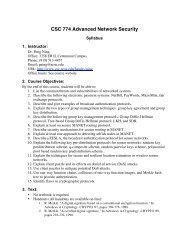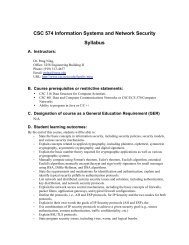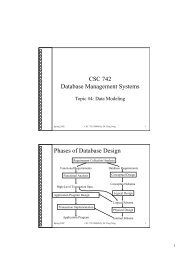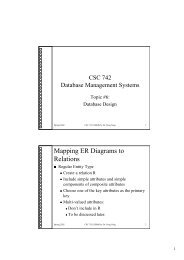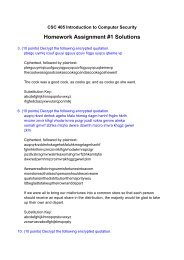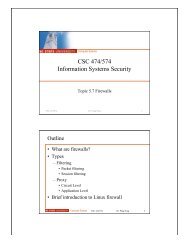A Flexible Approach to Intrusion Alert Anonymization and Correlation
A Flexible Approach to Intrusion Alert Anonymization and Correlation
A Flexible Approach to Intrusion Alert Anonymization and Correlation
You also want an ePaper? Increase the reach of your titles
YUMPU automatically turns print PDFs into web optimized ePapers that Google loves.
A <strong>Flexible</strong> <strong>Approach</strong> <strong>to</strong> <strong>Intrusion</strong> <strong>Alert</strong> <strong>Anonymization</strong> <strong>and</strong> <strong>Correlation</strong><br />
Dingbang Xu <strong>and</strong> Peng Ning<br />
Cyber Defense Labora<strong>to</strong>ry<br />
Department of Computer Science<br />
North Carolina State University<br />
Raleigh, NC 27695-8206<br />
Email: {dxu, pning}@ncsu.edu<br />
Abstract<br />
<strong>Intrusion</strong> alert data sets are critical for security research<br />
such as alert correlation. However, privacy concerns about<br />
the data sets from different data owners may prevent data<br />
sharing <strong>and</strong> investigation. It is always desirable <strong>and</strong> sometimes<br />
m<strong>and</strong>a<strong>to</strong>ry <strong>to</strong> anonymize sensitive data in alert sets<br />
before they are shared <strong>and</strong> analyzed. To address privacy<br />
concerns, in this paper we propose three schemes <strong>to</strong> flexibly<br />
perform alert anonymization. These schemes are closely<br />
related but can also be applied independently. In Scheme<br />
I, we generate artificial alerts <strong>and</strong> mix them with original<br />
alerts <strong>to</strong> help hide original attribute values. In Scheme II,<br />
we further map sensitive attributes <strong>to</strong> r<strong>and</strong>om values based<br />
on concept hierarchies. In Scheme III, we propose <strong>to</strong> partition<br />
an alert set in<strong>to</strong> multiple subsets <strong>and</strong> apply Scheme<br />
II in each subset independently. To evaluate privacy protection<br />
<strong>and</strong> guide alert anonymization, we define local privacy<br />
<strong>and</strong> global privacy, <strong>and</strong> use entropy <strong>to</strong> compute their values.<br />
Though we emphasize alert anonymization techniques<br />
in this paper, <strong>to</strong> examine data usability, we further perform<br />
correlation analysis for anonymized data sets. We focus on<br />
estimating similarity values between anonymized attributes<br />
<strong>and</strong> building attack scenarios from anonymized data sets.<br />
Our experimental results demonstrated the effectiveness of<br />
our techniques.<br />
1. Introduction<br />
To defend against large-scale distributed attacks such as<br />
worms <strong>and</strong> distributed denial of service (DDoS) attacks, it<br />
is usually desirable <strong>to</strong> deploy security systems such as intrusion<br />
detection systems (IDSs) over the Internet, moni<strong>to</strong>r<br />
different networks, collect security related data, <strong>and</strong> perform<br />
analysis <strong>to</strong> the collected data <strong>to</strong> extract useful information.<br />
In addition, different organizations, institutions <strong>and</strong><br />
users may also have the willingness <strong>to</strong> share their data for<br />
security research as long as their privacy concerns about the<br />
data can be fully satisfied. For example, DShield [27] collects<br />
firewall logs from different users <strong>to</strong> learn global cyber<br />
threats, <strong>and</strong> Department of Homel<strong>and</strong> Security sponsors<br />
PREDICT [19] project <strong>to</strong> create a reposi<strong>to</strong>ry collecting network<br />
operational data for cyber security research.<br />
Data generated by security systems may include sensitive<br />
information (e.g., IP addresses of compromised servers)<br />
that data owners do not want <strong>to</strong> disclose or share with other<br />
parties, where sensitive data are decided by data owners’<br />
privacy policy. It is always desirable <strong>and</strong> sometimes m<strong>and</strong>a<strong>to</strong>ry<br />
<strong>to</strong> anonymize sensitive data before they are shared <strong>and</strong><br />
correlated. To address this problem, existing approaches<br />
[13, 29] usually perform transformation <strong>to</strong> sensitive data.<br />
Fox example, Lincoln et al. [13] propose <strong>to</strong> use hash functions<br />
<strong>and</strong> keyed hash functions <strong>to</strong> anonymize sensitive attributes<br />
such as IP addresses. Their approach is effective on<br />
detecting high-volume events, but may have limitations on<br />
alert correlation if different keys are introduced in keyedhashing.<br />
Xu <strong>and</strong> Ning [29] propose <strong>to</strong> abstract original values<br />
<strong>to</strong> more general values (e.g., IP addresses are replaced<br />
by network addresses). Since general values may usually<br />
take different formats compared with original values (i.e.,<br />
they have different attribute domains), observing this may<br />
let malicious users immediately realize that attributes are<br />
sanitized, which may infer organizations’ privacy policy.<br />
In this paper, we address this problem in another complementary<br />
direction. We start <strong>to</strong> hide original sensitive values<br />
through injecting more data in<strong>to</strong> data sets. We also perform<br />
transformation <strong>to</strong> sensitive attributes, but this is carried<br />
over the same attribute domains. In this paper, we propose<br />
three schemes <strong>to</strong> anonymize sensitive attributes of intrusion<br />
alerts. These schemes are closely related <strong>and</strong> may also be<br />
applied independently. In Scheme I, we intentionally generate<br />
artificial alerts <strong>and</strong> mix them with original alerts, thus<br />
given any alert in the mixed set, it is not clear that this alert<br />
is original (i.e., IDS-reported) or artificial, which means its<br />
attributes may or may not be real. With both privacy <strong>and</strong> usability<br />
requirements in mind, during artificial alert genera-<br />
1
tion, we preserve frequency distributions of attack types <strong>and</strong><br />
non-sensitive attributes, while use concept hierarchies <strong>to</strong> facilitate<br />
the generation of sensitive attributes. A concept hierarchy<br />
can help us abstract attribute values, for example, IP<br />
addresses can be generalized <strong>to</strong> the corresponding network<br />
addresses. In Scheme II, we propose <strong>to</strong> map original sensitive<br />
attributes <strong>to</strong> r<strong>and</strong>om values based on concept hierarchies.<br />
And in Scheme III, we propose <strong>to</strong> partition an alert set<br />
in<strong>to</strong> multiple subsets based on time constraints <strong>and</strong> perform<br />
Scheme II independently for each subset. To measure data<br />
privacy hence <strong>to</strong> guide the procedure of alert anonymization,<br />
we propose two measures: local privacy <strong>and</strong> global<br />
privacy, <strong>and</strong> use entropy <strong>to</strong> compute their values.<br />
To underst<strong>and</strong> security threats involved in alert data sets,<br />
various alert correlation methods have been proposed in recent<br />
years. These methods usually focus on original alerts<br />
<strong>and</strong> can be roughly divided in<strong>to</strong> four groups. (1) <strong>Approach</strong>es<br />
based on similarity between alerts [24, 28, 5]. These approaches<br />
group alerts through computing similarity values<br />
between alert attributes. (2) <strong>Approach</strong>es based on prerequisites<br />
<strong>and</strong> consequences of attacks [6, 25, 17]. These methods<br />
model each attack through identifying its prerequisite<br />
(i.e., the necessary condition <strong>to</strong> launch an attack successfully)<br />
<strong>and</strong> consequence (i.e., the possible outcome if an attack<br />
succeeds), <strong>and</strong> matching consequences with prerequisites<br />
among different attacks <strong>to</strong> build attack scenarios. (3)<br />
<strong>Approach</strong>es based on known attack scenarios [15, 7]. These<br />
approaches build attack scenarios through matching alerts<br />
<strong>to</strong> known scenario templates. (4) <strong>Approach</strong>es based on multiple<br />
information sources [21, 16, 30]. Their goal is <strong>to</strong> analyze<br />
alerts from different security systems.<br />
Though we emphasize alert anonymization techniques in<br />
this paper, we also perform alert correlation <strong>to</strong> anonymized<br />
alerts <strong>to</strong> examine data usability. We focus on two problems:<br />
estimating similarity values between anonymized attributes<br />
<strong>and</strong> building attack scenarios from anonymized<br />
alert sets. Our method on similarity measurement is a probability<br />
based approach, which estimates how possible two<br />
anonymized attributes may have the same original values.<br />
Our approach on building attack scenarios extends from an<br />
existing method [17], where the probabilities related <strong>to</strong> the<br />
matching of prerequisites <strong>and</strong> consequences among different<br />
attacks are estimated. Though it is closely related <strong>to</strong><br />
the optimistic approach in [29], the probability estimation<br />
in our approach is based on our anonymization schemes.<br />
Based on these probabilities values, we can construct <strong>and</strong><br />
further “polish” attack scenarios. Our experimental results<br />
demonstrated the effectiveness of our techniques in terms of<br />
various measures.<br />
The remainder of this paper is organized as follows. In<br />
the next section, we present three schemes <strong>to</strong> anonymize<br />
alerts. In Section 3, we discuss techniques <strong>to</strong> correlate<br />
anonymized alert sets. In Section 4, we show our experimental<br />
results. In Section 5, we discuss related work. And<br />
in Section 6, we conclude this paper <strong>and</strong> point out further<br />
directions.<br />
2. Three Schemes for <strong>Alert</strong> <strong>Anonymization</strong><br />
In this paper, we emphasize our alert anonymization<br />
techniques, which can flexibly protect data privacy. Before<br />
we go in<strong>to</strong> the details of our techniques, we clarify some notions<br />
<strong>and</strong> definitions first.<br />
An alert type is a type name T <strong>and</strong> a set S of attribute<br />
names, where each attribute name in S has a related domain<br />
denoting possible attribute values. As an example,<br />
an alert type FTP AIX Overflow has a set of six attribute<br />
names {SrcIP, SrcPort, DestIP, DestPort, StartTime, End-<br />
Time}, where the type name FTP AIX Overflow denotes<br />
that it is a buffer overflow attack targeting AIX ftp services,<br />
<strong>and</strong> all six attributes are used <strong>to</strong> describe this type of attacks.<br />
The domains of SrcIP <strong>and</strong> DestIP are all possible IP<br />
addresses, the domains of SrcPort <strong>and</strong> DestPort are possible<br />
port numbers (from port 0 <strong>to</strong> port 65535), <strong>and</strong> StartTime<br />
<strong>and</strong> EndTime denote the timestamps that the attack begins<br />
<strong>and</strong> finishes, respectively.<br />
An original alert is an instance of alert types <strong>and</strong> is reported<br />
by security systems. Formally, a type T original alert<br />
t o is a tuple on T ’s attribute set S, where each attribute value<br />
in this tuple is a value in the related domain. For example,<br />
assume we have a type FTP AIX Overflow alert {SrcIP<br />
=172.16.10.28, SrcPort =1081, DestIP =172.16.30.6, Dest-<br />
Port =21, StartTime =01-16-2006 18:01:05, EndTime<br />
=01-16-2006 18:01:05}. This alert describes an FTP AIX<br />
Overflow attack from IP address 172.16.10.28 <strong>to</strong> target<br />
172.16.30.6. A type T artificial alert has the same<br />
format as that of an original alert. The only difference between<br />
them is that original alerts are reported by security<br />
systems, while artificial alerts are synthetic, <strong>and</strong> may<br />
be generated by a human user, or some programs. Similarly,<br />
a type T anonymized alert has the same format as that<br />
of an original alert. However, sensitive attribute values in<br />
anonymized alerts are transformed (e.g., through r<strong>and</strong>omization)<br />
<strong>to</strong> protect data privacy. As an example, if DestIP of<br />
the alert in the above example is sensitive, we may transform<br />
DestIP=172.16.30.6 <strong>to</strong> DestIP=172.16.30.35. In the<br />
rest of this paper, we call the alert set including both original<br />
<strong>and</strong> artificial alerts the mixed alert set. For convenience,<br />
we may also use attributes <strong>to</strong> represent either<br />
attribute names, attribute values, or both.<br />
2.1. Scheme I: Artificial <strong>Alert</strong> Injection Based on<br />
Concept Hierarchies<br />
Intuitively, artificial alert injection generates synthetic<br />
alerts <strong>and</strong> mixes them with original alerts. Given any alert in<br />
2
a mixed alert set, identifying whether it is artificial or original<br />
is difficult, which means the information disclosed by<br />
any individual alert may not necessarily be true. The critical<br />
issue here is how <strong>to</strong> generate attribute values for artificial<br />
alerts, with both privacy <strong>and</strong> usability requirements<br />
in mind. We divide alert attributes in<strong>to</strong> three classes: alert<br />
types, sensitive attributes, <strong>and</strong> non-sensitive attributes, <strong>and</strong><br />
discuss them separately.<br />
<strong>Alert</strong> types encode valuable information about the corresponding<br />
attacks. For example, RealSecure network sensor<br />
6.5 [10] may report an FTP AIX Overflow attack. Based<br />
on the signature of this attack, we know that it is a buffer<br />
overflow attack targeting AIX FTP services. <strong>Alert</strong> types are<br />
crucial for security officers <strong>to</strong> learning security threats. So<br />
when we create artificial alerts, we propose <strong>to</strong> preserve the<br />
frequency of the original data set in terms of alert types,<br />
where the frequency of an alert type T is the ratio of the<br />
number of alerts with type T <strong>to</strong> the <strong>to</strong>tal number of alerts. In<br />
other words, if an original alert data set has n types of alerts<br />
with frequencies p 1 , p 2 , · · · , p n where p 1 +p 2 + · · ·+p n =<br />
1, then in our artificial alert set, we will maintain this frequency<br />
distribution.<br />
Sensitive attributes are decided by privacy policy, <strong>and</strong><br />
their values are what we try <strong>to</strong> protect. Considering both privacy<br />
<strong>and</strong> usability concerns, we propose <strong>to</strong> use concept hierarchies<br />
<strong>to</strong> help us artificially generate sensitive attribute<br />
values. Creating attribute values based on concept hierarchies<br />
may preserve some useful information (e.g., prefixes<br />
of IP addresses), but also change attribute distributions <strong>to</strong><br />
certain degree <strong>to</strong> protect alert privacy. Now let us first introduce<br />
concept hierarchies.<br />
Concept hierarchies have been used in areas such as data<br />
mining [9] <strong>and</strong> also in privacy-preserving techniques (e.g.,<br />
k−Anonymity approach [23] <strong>and</strong> privacy-preserving alert<br />
correlation [29]). A concept hierarchy is based on specificgeneral<br />
relations. Given two concepts c 1 <strong>and</strong> c 2 (e.g., attribute<br />
values), if c 1 is more specific than c 2 (or, c 2 is more<br />
general than c 1 ), we say there is a specific-general relation<br />
between c 1 <strong>and</strong> c 2 , <strong>and</strong> denote it as c 1 ≼ c 2 . As an example,<br />
given an IP address 172.16.10.3 <strong>and</strong> a network address<br />
172.16.10.0/24, we have 172.16.10.3 ≼ 172.16.10.0/24.<br />
Specific-general relations can be obtained through abstracting<br />
a set of low-level concepts <strong>to</strong> a high-level concept. For<br />
example, a set of individual IP addresses can be organized<br />
in<strong>to</strong> a subnet. Based on specific- general relations, a concept<br />
hierarchy is a set of specific-general relations <strong>and</strong> is<br />
usually organized in<strong>to</strong> a tree. Figure 1 shows a concept hierarchy<br />
for IP addresses 172.16.11.0, · · · , 172.16.11.255 <strong>and</strong><br />
172.16.12.0, · · · , 172.16.12.255, where each IP address is<br />
first generalized <strong>to</strong> its /24 network address, <strong>and</strong> then <strong>to</strong> its<br />
/16 network address.<br />
For continuous attributes, we can group data in<strong>to</strong> bins<br />
thus continuous values can be transformed in<strong>to</strong> categori-<br />
172.16.0.0/16<br />
172.16.11.0/24 172.16.12.0/24<br />
172.16.11.0 ...... 172.16.11.255 172.16.12.0 ...... 172.16.12.255<br />
Figure 1. An example concept hierarchy<br />
cal. For example, given a set of timestamps within a onehour<br />
time interval, we may partition the whole time interval<br />
in<strong>to</strong> 60 equal-length bins, <strong>and</strong> put timestamps in<strong>to</strong> the corresponding<br />
bins. Binning techniques have been extensively<br />
studied in the fields such as data mining <strong>and</strong> statistics, <strong>and</strong><br />
we do not repeat them here. In this paper, our techniques focus<br />
on categorical data, though they can be extended <strong>to</strong> accommodate<br />
continuous data.<br />
Given a concept hierarchy H, <strong>and</strong> two nodes v s <strong>and</strong> v g in<br />
H where v s ≼ v g (v s has a path <strong>to</strong> v g in H), the distance between<br />
v s <strong>and</strong> v g is the number of edges over the path from<br />
v s <strong>to</strong> v g , denoted as distance(v s , v g ). For example, in Figure<br />
1, distance(172.16.11.3, 172.16.11.0/24)= 1. Given<br />
a concept hierarchy H <strong>and</strong> two nodes v s1 <strong>and</strong> v s2 in H,<br />
we call a node v g in H the least common parent if (1)<br />
v s1 ≼ v g , (2) v s2 ≼ v g , <strong>and</strong> (3) d m =max(distance(v s1 , v g ),<br />
distance(v s2 , v g )) has a minimum value. In addition, if v s1<br />
<strong>and</strong> v s2 are both leaf nodes in H <strong>and</strong> the least common<br />
parent v g has <strong>to</strong>tal L leaf nodes including v s1 <strong>and</strong> v s2 ,<br />
we call nodes v s1 <strong>and</strong> v s2 L-peer nodes, or simply L-<br />
peers. For example, in Figure 1, the least common parent<br />
of two leaf nodes 172.16.11.3 <strong>and</strong> 172.16.11.5 is node<br />
172.16.11.0/24. Since 172.16.11.0/24 has <strong>to</strong>tally 256 leaf<br />
nodes, 172.16.11.3 <strong>and</strong> 172.16.11.5 are 256-peers.<br />
Now let us discuss how <strong>to</strong> generate sensitive attributes<br />
for artificial alerts. We assume each sensitive attribute value<br />
has a desirable general value in concept hierarchies, where<br />
these desirable general values can be derived through a<br />
given parameter L denoting the desirable number of peer<br />
nodes. For example, if L = 256 for attribute DestIP, then<br />
the desirable general values for these IP addresses are the<br />
corresponding /24 network addresses. We first compute the<br />
frequency distribution of these generalized attribute values<br />
based on the original data set. Next, following the computed<br />
frequency distribution, we create generalized attribute values<br />
in the artificial alert set, finally we replace these generalized<br />
values using leaf nodes in the corresponding hierarchies<br />
(each leaf node value has equal probability <strong>to</strong> be chosen).<br />
Notice that during the above procedure, we preserve<br />
attribute frequency in terms of general values. This is because<br />
these general values partially maintain the usability<br />
of alert data (e.g., prefixes of IP address). We also replace<br />
these general values using their corresponding leaf nodes<br />
with uniform distribution. This may help us change the distribution<br />
of attributes in original sets. For example, if in<br />
3
an original set, the values for attribute DestIP is only from<br />
172.16.11.0 <strong>to</strong> 172.16.11.31. Further suppose we set parameter<br />
L = 256. Then we will generate artificial attributes<br />
uniformly distributed from 172.16.11.0 <strong>to</strong> 172.16.11.255 <strong>to</strong><br />
change attribute distribution <strong>and</strong> hence protect original values.<br />
Notice that desirable general values (or, parameter L)<br />
for sensitive attributes are decided by privacy policy. For example,<br />
if we let DestIP’s desirable general values be the corresponding<br />
/24 network addresses, this means that ideally,<br />
we want each DestIP in its /24 network <strong>to</strong> be equally likely<br />
in alert sets, so malicious users may not be able <strong>to</strong> “guess”<br />
which values are more possible.<br />
To generate non-sensitive attributes, we first compute the<br />
frequency distribution of their original values, then we generate<br />
artificial attribute values with the same frequency distribution<br />
in the artificial alert set. As a special case, for<br />
timestamp information, we first get the minimum <strong>and</strong> maximum<br />
timestamps for each alert type in the original alert set,<br />
then we uniformly choose timestamps between the minimum<br />
<strong>and</strong> maximum values for artificial alerts.<br />
Another important issue on artificial alert generation is<br />
<strong>to</strong> decide how many alerts <strong>to</strong> generate. Notice that injecting<br />
artificial alert data usually may change the distribution<br />
of attribute values. Intuitively, if a large number of artificial<br />
alerts are generated, we may better protect alert privacy (attributes<br />
are more uniformly distributed), but alert usability<br />
may decrease. On the other h<strong>and</strong>, if only a small number of<br />
alerts are created, we may increase alert usability, but alert<br />
privacy may decrease. So the ideal case is <strong>to</strong> flexibly control<br />
the difference between attribute distributions based on<br />
the requirement of privacy protection.<br />
We propose <strong>to</strong> use the distance between probability mass<br />
functions (PMFs) <strong>to</strong> measure the difference between attribute<br />
distributions. Given one attribute A s in both original<br />
alert set S o <strong>and</strong> mixed alert set S m , assume the PMFs<br />
for A s in S o <strong>and</strong> S m are f o (x) <strong>and</strong> f m (x), respectively,<br />
where x is possible values for A s . Further assume the domain<br />
of attribute A s is Dom(A s ). To calculate the distance<br />
between two PMFs, we first need define distance function<br />
D(f o , f m ) between f o (x) <strong>and</strong> f m (x). As an example,<br />
we can set D(f o , f m ) = ∑ x∈Dom(A s) |f m(x) − f o (x)|.<br />
Through setting a desirable distance threshold, we may inject<br />
the number of alerts satisfying the threshold. (In case<br />
sensitive attributes in original sets are in uniform distribution,<br />
we may further specify a maximum number of artificial<br />
alerts <strong>to</strong> prevent infinite alert injection.)<br />
Notice that in our above discussion, we do not consider<br />
the dependence between different attributes (e.g., the dependence<br />
between attributes DestIP <strong>and</strong> DestPort). When there<br />
are no such dependence, we can use the proposed method<br />
above <strong>to</strong> generate all alerts. However, when there does exist<br />
the dependence, we need <strong>to</strong> h<strong>and</strong>le this situation with<br />
caution. As an example, if there are only one web server<br />
172.16.10.5 with port 80 open in a network, then usually<br />
all those web based attacks are targeting 172.16.10.5 on<br />
port 80. This means IP address 172.16.10.5 <strong>and</strong> port number<br />
80 are dependent in web based attacks. Artificial alert<br />
generation, on the one h<strong>and</strong>, does not require <strong>to</strong> strictly satisfy<br />
this dependence, because the violation of this dependence<br />
may bring confusion <strong>to</strong> <strong>and</strong> require further investigation<br />
from malicious users, which in some sense may protect<br />
data privacy. However, on the other h<strong>and</strong>, if we try <strong>to</strong> make<br />
artificial <strong>and</strong> original alerts very difficult <strong>to</strong> distinguish, or<br />
data usability is our favorable concern, we can also maintain<br />
attribute dependence in artificial alert generation. We<br />
propose two ways <strong>to</strong> get dependence relationships.<br />
1. Manually collect all dependence relationships through<br />
various means. For example, based on attack signatures, <strong>and</strong><br />
host configurations, we can know the hosts <strong>and</strong> ports that<br />
some attacks are targeting.<br />
2. Compute conditional probabilities between attribute<br />
values based on original alert sets, <strong>and</strong> follow these conditional<br />
probabilities <strong>to</strong> generate attribute values in artificial<br />
alert sets. This approach is similar <strong>to</strong> the data-swapping<br />
technique proposed by Reiss [22].<br />
To see how well our anonymization schemes can protect<br />
alert data privacy, we classify alert data privacy in<strong>to</strong> two<br />
levels: local privacy <strong>and</strong> global privacy. Local privacy is related<br />
<strong>to</strong> original attribute values in each individual alert. Intuitively,<br />
if the original value for a sensitive attribute in an<br />
alert has been known, the local privacy for the sensitive attribute<br />
in this alert is compromised. The second level of alert<br />
data privacy is global privacy, which is related <strong>to</strong> the distributions<br />
of sensitive attributes in alert set. Intuitively, if the<br />
distribution of a sensitive attribute in an original alert set is<br />
known, we can derive useful information about the original<br />
set (e.g., the most possible value in the data set). For both local<br />
<strong>and</strong> global privacy, we use entropy [4] <strong>to</strong> measure them.<br />
Suppose that we have a value v s for a sensitive attribute A s<br />
in a alert t. Based on v s , if we can estimate the possible<br />
original values of A s in t <strong>and</strong> the corresponding probability<br />
for each possible value, then we can compute alert t’s<br />
local privacy H l (t) = − ∑ p i log 2 p i , where p i is the probability<br />
for a possible value. Given all attribute values for a<br />
sensitive attribute A s in an alert set S, we can estimate S’<br />
global privacy H g (S) = − ∑ P(v i )log 2 P(v i ), where v i<br />
is a possible value for A s in S, <strong>and</strong> P(v i ) is the corresponding<br />
probability. To help us better underst<strong>and</strong> global privacy,<br />
we may explain it from a r<strong>and</strong>om variable point of view.<br />
Assume that a sensitive attribute is a r<strong>and</strong>om variable, <strong>and</strong><br />
all values for this attribute in an alert set is a realization of<br />
this r<strong>and</strong>om variable. Then the global privacy for this attribute<br />
in the alert set is a r<strong>and</strong>omness (or uncertainty) measure<br />
about the realization of this r<strong>and</strong>om variable. Recall<br />
that we generate uniformly distributed data (based on concept<br />
hierarchies) during artificial alert injection. The reason<br />
4
is that injecting uniformly distributed data generally may<br />
increase the r<strong>and</strong>omness of data sets. Also notice that the<br />
distance between PMFs <strong>and</strong> the change in global privacy<br />
are closely related because we change attribute distributions<br />
through injecting uniformly distributed data. And it is also<br />
feasible <strong>to</strong> control the number of artificial alerts through adjusting<br />
the change in global privacy.<br />
Back <strong>to</strong> artificial alert injection, if original alert set S o<br />
has m alerts, we inject n artificial alerts in it. Thus in<br />
mixed set S m including both original <strong>and</strong> artificial alerts,<br />
we have <strong>to</strong>tal m + n alerts. In S m , each individual alert<br />
m<br />
m+n<br />
n<br />
has probability<br />
m+n<br />
<strong>to</strong> be original, <strong>and</strong> probability<br />
<strong>to</strong> be artificial. So its local privacy is − ∑ p i log 2 p i =<br />
m<br />
m+n log 2 m+n<br />
m + n<br />
m+n log 2 m+n<br />
n<br />
. We can also calculate<br />
global privacy for both S o <strong>and</strong> S m , <strong>and</strong> compute their difference<br />
<strong>to</strong> see how well we can improve global privacy. One of<br />
our later experiments shows that through injecting 168 artificial<br />
alerts in<strong>to</strong> an original set with 922 alerts, we achieve<br />
local privacy with value 0.62, <strong>and</strong> we improve global privacy<br />
from 4.696 <strong>to</strong> 5.692 (the distance between two PMFs<br />
is 0.3).<br />
2.2. Scheme II: Attribute R<strong>and</strong>omization Based<br />
on Concept Hierarchies<br />
In Scheme I, we inject artificial alerts in<strong>to</strong> original data<br />
set. For any individual alert in the mixed alert set, it may<br />
be difficult <strong>to</strong> identify whether this alert is original or artificial,<br />
hence sensitive attribute values in any single alert have<br />
a chance <strong>to</strong> be faked.<br />
Let us look at Scheme I in detail. Assume that we have m<br />
original alerts, <strong>and</strong> inject n artificial alerts in<strong>to</strong> it. Hence in<br />
m<br />
m+n<br />
the mixed alert set, each alert has a probability <strong>to</strong> be<br />
original. Based on probability theory, r<strong>and</strong>omly pick up k<br />
alerts in the mixed set, the probability that at least one alert<br />
is original is 1 − (<br />
n<br />
m+n )k . As an example, let m = 1000,<br />
n = 300 <strong>and</strong> k = 2, then the probability that at least one<br />
alert is original is 94.67%, while the probability that both<br />
alerts are artificial is only 5.33%. This tells us that when the<br />
ratio of the number of artificial alerts <strong>to</strong> the <strong>to</strong>tal number<br />
of alerts is small, it is very likely that some alerts in an alert<br />
subset are original even if this subset is small. Closely investigating<br />
these small subsets may disclose the privacy of alert<br />
data. This problem may be mitigated by injecting more artificial<br />
alerts. In the extreme case, if we inject a much larger<br />
number of artificial alerts (i.e., m ≪ n), then in a r<strong>and</strong>omly<br />
selected k-alert subset, the probability that at least one alert<br />
is original may be very small even if k is big. For example,<br />
let m = 1, 000 <strong>and</strong> n = 1, 000, 000. When k = 100, the<br />
probability that at least one alert is original is only 9.51%,<br />
<strong>and</strong> even when k = 1, 000, the probability value only increases<br />
<strong>to</strong> 63.19%. Notice that with the increase of the number<br />
of artificial alerts, the usability of mixed data sets may<br />
be decreasing, <strong>and</strong> more overhead is introduced <strong>to</strong> analyze<br />
mixed alert sets. Considering privacy, usability, <strong>and</strong> performance,<br />
we propose <strong>to</strong> apply r<strong>and</strong>omization <strong>to</strong> sensitive attributes,<br />
which may allow us protect the privacy of original<br />
alerts without injecting a huge amount of artificial alerts.<br />
Notice that our r<strong>and</strong>omization algorithm takes advantage of<br />
concept hierarchies, which can preserve some useful information<br />
in sensitive attributes (e.g., prefixes of IP addresses).<br />
Though we motivate attribute r<strong>and</strong>omization in term of<br />
mixed alert sets, it can be applied <strong>to</strong> original alert sets.<br />
Given a parameter L denoting the desirable number of<br />
peers in concept hierarchies, the basic idea of our algorithm<br />
is <strong>to</strong> r<strong>and</strong>omize each different attribute value v i uniformly<br />
<strong>to</strong> any of v i ’s L-peers (In other words, the mapping<br />
<strong>and</strong> mapped values has a common general value v g<br />
where v g has L leaf nodes). For example, based on the<br />
concept hierarchy in Figure 1, we may r<strong>and</strong>omize a sensitive<br />
attribute DestIP=172.16.11.8 <strong>to</strong> DestIP=172.16.11.56<br />
if L = 256. During r<strong>and</strong>omization, we keep consistency in<br />
attribute mapping, which means if two alerts has the same<br />
original values for an attribute A s , then the mapped values<br />
for A s in both alerts are the same. For convenience, we<br />
call the mapped value the image value, or simply the image.<br />
This consistency is helpful <strong>to</strong> maintain data usability.<br />
To see how attribute r<strong>and</strong>omization may help protect<br />
alert privacy, let us take a look at both local <strong>and</strong> global privacy.<br />
Suppose that we r<strong>and</strong>omize a sensitive attribute A s in<br />
an original alert set. After performing r<strong>and</strong>omization, given<br />
any image value v r , we know the original value of v r may<br />
be any of v r ’s L-peers with equal probability (i.e., 1 L<br />
). Thus<br />
the local privacy value is − ∑ L<br />
i=1 1 L log 2 1 L = log 2 L. If we<br />
r<strong>and</strong>omize a mixed alert set, we can also derive the corresponding<br />
local privacy after considering the probability that<br />
a given alert may be original. On the other h<strong>and</strong>, based on<br />
concept hierarchies <strong>and</strong> requirements for local privacy values,<br />
we may choose desirable parameters (e.g., L) satisfying<br />
the requirements. To consider global privacy, let us assume<br />
that there are k distinct values for sensitive attribute<br />
A s in an alert set S. Since we keep consistency during r<strong>and</strong>omization,<br />
there will be at most k distinct image values<br />
for A s in r<strong>and</strong>omized alert set S r . If k distinct image values<br />
do exist, then S r have the same global privacy as in S.<br />
When less than k distinct image values are generated (this<br />
is possible because two different original values may happen<br />
<strong>to</strong> be r<strong>and</strong>omized <strong>to</strong> the same value), the global privacy<br />
value H g (S r ) in S r may change compared with the value in<br />
S, where H g (S r ) may be slightly smaller. Our later experimental<br />
results confirm this conjecture. For example, in one<br />
data set, we set L = 256, <strong>and</strong> the global privacy slightly<br />
changes from 5.692 (before r<strong>and</strong>omization) <strong>to</strong> 5.671 (after<br />
r<strong>and</strong>omization). To summarize, our attribute r<strong>and</strong>omization<br />
may result in slight change (or no change) in global privacy,<br />
<strong>and</strong> desirable change (through choosing appropriate param-<br />
5
eters) in local privacy.<br />
2.3. Scheme III: <strong>Alert</strong> Set Partitioning <strong>and</strong> Attribute<br />
R<strong>and</strong>omization<br />
In Scheme II, we r<strong>and</strong>omize sensitive attribute values <strong>to</strong><br />
their L-peers <strong>and</strong> maintain consistency during r<strong>and</strong>omization.<br />
A limitation related <strong>to</strong> this scheme is that once attackers<br />
get <strong>to</strong> know some (original value, image value) pairs,<br />
then for all the image values in the known pairs, attackers<br />
know their corresponding original values in the whole<br />
alert set. Notice that (original value, image value) pairs can<br />
be obtained through various means, for example, deliberately<br />
attacking some special hosts <strong>and</strong> examining published<br />
alert data (e.g., counting frequencies of some attacks). To<br />
mitigate this problem, we propose <strong>to</strong> partition an alert set<br />
in<strong>to</strong> multiple subsets <strong>and</strong> perform attribute r<strong>and</strong>omization<br />
(Scheme II) in each subset independently. Thus one original<br />
value may be mapped <strong>to</strong> different image values in different<br />
subsets.<br />
Our algorithm on partitioning an alert set is based on<br />
a time constraint. Given a time interval I (e.g., 2 hours)<br />
<strong>and</strong> a set S of alerts, we say S satisfy time constraint I if<br />
|max(EndTime) − min(StartTime)| ≤ I (i.e., the difference<br />
between the maximum EndTime <strong>and</strong> the minimum<br />
StartTime in S is less than or equal <strong>to</strong> I). Based on a time<br />
constraint, we partition an alert set in<strong>to</strong> multiple subsets<br />
such that each subset satisfies the time constraint, then we<br />
r<strong>and</strong>omize each subset through Scheme II independently.<br />
Now let us look at local <strong>and</strong> global privacy under Scheme<br />
III. For local privacy, since image values are chosen uniformly<br />
from L-peers, we have a similar analysis as in<br />
Scheme II. However, for global privacy, since it is possible<br />
that one original value in different subsets may be r<strong>and</strong>omized<br />
<strong>to</strong> different image values, global privacy usually may<br />
increase compared with applying Scheme II. Our later experiments<br />
confirm our conjecture. For example, in one experiment,<br />
we partitioned one data set in<strong>to</strong> four subsets, <strong>and</strong><br />
global privacy increased from 5.692 <strong>to</strong> 6.955.<br />
3. Anonymized <strong>Alert</strong> <strong>Correlation</strong><br />
Though our focus in this paper is alert anonymization,<br />
we are also interested in the usability of anonymized alert<br />
sets. Notice that current alert correlation approaches usually<br />
concentrate on computing similarity values between alert<br />
attributes, or building attack scenarios <strong>to</strong> reflect attackers’<br />
activities. So in this section, we will focus on these two<br />
problems under the situation that alerts are anonymized.<br />
Notice that our approach is closely related <strong>to</strong> a previous<br />
method [29], however, the alerts that we correlate are<br />
anonymized by the schemes proposed in this paper.<br />
3.1. Similarity Estimation<br />
Similarity measurement computes how similar two attributes<br />
are, usually with a value between 0 <strong>and</strong> 1. Existing<br />
approaches [28, 24, 11] focus on measuring similarity<br />
between original attributes. Our anonymization techniques<br />
(Schemes II <strong>and</strong> III) r<strong>and</strong>omize original attributes <strong>to</strong> their<br />
peers. Thus it is crucial <strong>and</strong> helpful <strong>to</strong> estimate similarity<br />
between original attributes only using anonymized values.<br />
In the following, we first give an example function on computing<br />
similarity between original values, then discuss how<br />
<strong>to</strong> estimate similarity based on anonymized attributes.<br />
Assume that we have a sensitive attribute A s <strong>and</strong> two<br />
original attributes values x 1 <strong>and</strong> x 2 for A s . As an example<br />
similarity function, we let Sim(x 1 , x 2 ) = 1 if x 1 = x 2 ,<br />
<strong>and</strong> Sim(x 1 , x 2 ) = 0 if x 1 ≠ x 2 . We further assume x 1<br />
<strong>and</strong> x 2 ’s images are y 1 <strong>and</strong> y 2 , respectively, after r<strong>and</strong>omization.<br />
We consider two cases regarding whether x 1 <strong>and</strong> x 2<br />
are in the same subset (an set is partitioned in Scheme III).<br />
(1) When x 1 <strong>and</strong> x 2 are in the same subset, we have the<br />
following observation.<br />
Observation 1 For a sensitive attribute A s , given two original<br />
attribute values x 1 <strong>and</strong> x 2 where they are in the same<br />
subset, <strong>and</strong> two image values y 1 <strong>and</strong> y 2 r<strong>and</strong>omized from x 1<br />
<strong>and</strong> x 2 using Scheme II (with same parameters such as L),<br />
we know that (i) if x 1 = x 2 , then y 1 = y 2 ; (ii) if y 1 = y 2 ,<br />
x 1 <strong>and</strong> x 2 may or may not be the same.<br />
We explain our observation through examples. Assume<br />
x 1 <strong>and</strong> x 2 are both destination IP addresses where x 1 =<br />
172.16.11.5. Using the concept hierarchy in Figure 1, suppose<br />
we r<strong>and</strong>omize x <strong>to</strong> one of its 256-peer nodes, <strong>and</strong> x 1 is<br />
mapped <strong>to</strong> y 1 with value 172.16.11.98. Since we keep consistency<br />
in Scheme II, if x 2 = 172.16.11.5, then we know<br />
y 2 = y 1 = 172.16.11.98. On the other h<strong>and</strong>, if x 2 ≠ x 1 ,<br />
for example, let x 2 = 172.16.11.9, then y 2 can be any IP<br />
address from 172.16.11.0 <strong>to</strong> 172.16.11.255, which has a<br />
chance <strong>to</strong> be 172.16.11.98. To better characterize this observation,<br />
we compute the following probabilities.<br />
For simplicity, assume the domain of x is L specific<br />
values where each value has equal probability <strong>to</strong> be chosen,<br />
<strong>and</strong> two original values x 1 <strong>and</strong> x 2 are r<strong>and</strong>omized<br />
using their L-peer nodes. Based on conditional probability<br />
<strong>and</strong> <strong>to</strong>tal probability theorems, we can derive P(x 1 =<br />
x 2 |y 1 = y 2 ) =<br />
L<br />
2L−1<br />
. (How we derive this probability<br />
is shown in Appendix A.) Similarly, we can get P(x 1 ≠<br />
x 2 |y 1 = y 2 ) = L−1<br />
2L−1 , P(x 1 = x 2 |y 1 ≠ y 2 ) = 0, <strong>and</strong><br />
P(x 1 ≠ x 2 |y 1 ≠ y 2 ) = 1. Notice that though we use the<br />
assumption of uniform distribution about original values <strong>to</strong><br />
L<br />
2L−1<br />
derive P(x 1 = x 2 |y 1 = y 2 ) = , we can prove that for<br />
other distributions, we have P(x 1 = x 2 |y 1 = y 2 ) ≥<br />
L<br />
2L−1<br />
as long as the attribute domain is the same. We prove it<br />
through Lemma 1 in Appendix A.<br />
6
(2) When x 1 <strong>and</strong> x 2 are in different subset, x 1 <strong>and</strong> x 2 are<br />
r<strong>and</strong>omized independently. Assume their r<strong>and</strong>omization has<br />
the same input parameters (e.g., L). With the similar reasoning<br />
as in (1), we know that as long as x 1 <strong>and</strong> x 2 are L-peers,<br />
y 1 <strong>and</strong> y 2 have a chance <strong>to</strong> be the same. Under the same assumption<br />
as in (1), we derive P(x 1 = x 2 |y 1 = y 2 ) = 1 L ,<br />
P(x 1 ≠ x 2 |y 1 = y 2 ) = L−1<br />
L , P(x 1 = x 2 |y 1 ≠ y 2 ) = 1 L ,<br />
<strong>and</strong> P(x 1 ≠ x 2 |y 1 ≠ y 2 ) = L−1<br />
L .<br />
As an example <strong>to</strong> estimate similarity between y 1 <strong>and</strong> y 2 ,<br />
we estimate how possible their corresponding x 1 <strong>and</strong> x 2 are<br />
the same, <strong>and</strong> use this probability as their similarity value.<br />
Based on our above assumption <strong>and</strong> reasoning, we can get<br />
an example similarity function for anonymized attributes as<br />
follows. Sim(y 1 , y 2 ) =<br />
•<br />
L<br />
2L−1 , if (y 1 <strong>and</strong> y 2 are L-peers) ∧ (y 1 = y 2 ) ∧ (y 1 <strong>and</strong><br />
y 2 in the same subset),<br />
• 1 L , if (y 1 <strong>and</strong> y 2 are L-peers) ∧ (y 1 <strong>and</strong> y 2 in different<br />
subsets),<br />
• 0, otherwise.<br />
Notice that <strong>to</strong> derive the new similarity function above,<br />
we only consider a simple case regarding how possible original<br />
attributes may be the same. For more complicated case,<br />
we may apply a similar, probability-based approach <strong>to</strong> derive<br />
new functions for anonymized attributes.<br />
3.2. Building Attack Scenarios<br />
Attack scenarios help us underst<strong>and</strong> what steps adversaries<br />
take <strong>to</strong> attack victim machines. For example, an attacker<br />
may first run IP sweep <strong>to</strong> detect live IP addresses,<br />
followed by port scanning attacks <strong>to</strong> look for open ports,<br />
<strong>and</strong> finally launch buffer overflow attacks <strong>to</strong> compromise<br />
live hosts. To build attack scenarios, it is crucial <strong>to</strong> identify<br />
causal relations between individual attacks. For example,<br />
in the scenario above, there is a causal relation between<br />
the earlier IP sweep attack <strong>and</strong> the later port scanning attack<br />
because the first one may detect live IP addresses for<br />
the second one <strong>to</strong> further probe.<br />
There are several approaches being proposed <strong>to</strong> build attack<br />
scenarios. For example, known attack scenario based<br />
approaches [7, 15], <strong>and</strong> prerequisite <strong>and</strong> consequence based<br />
methods [25, 6, 17]. These approaches can build attack<br />
scenarios when original attributes are known. To build attack<br />
scenarios from anonymized alerts, we use a probability<br />
based approach, which is extended from previous correlation<br />
methods [17, 29]. In the following, we start with an<br />
overview of a previous correlation method [17], with slight<br />
modification <strong>to</strong> facilitate our discussion.<br />
3.2.1. An Overview of a <strong>Correlation</strong> Method [17]. In<br />
correlation method [17], each alert type is associated with<br />
its prerequisite <strong>and</strong> consequence, where the prerequisite of<br />
an attack is the necessary condition for the attack <strong>to</strong> be successful,<br />
<strong>and</strong> the consequence of an attack is the possible<br />
outcome if the attack succeeds. We use predicates <strong>to</strong> represent<br />
prerequisites <strong>and</strong> consequences, where the variables in<br />
predicates are the attribute names in alert types.<br />
Example 1 Given an alert type FTP AIX Overflow, its<br />
prerequisite is ExistService(DestIP,DestPort), <strong>and</strong> its consequence<br />
is {GainAccess(DestIP)}, which means the necessary<br />
condition of an FTP AIX Overflow attack is that FTP<br />
service is running on DestIP at DestPort, <strong>and</strong> the consequence<br />
is that attackers may gain unauthorized access <strong>to</strong><br />
DestIP.<br />
To further characterize prerequisites <strong>and</strong> consequences<br />
of attack instances (i.e., alerts), we can instantiate<br />
prerequisites <strong>and</strong> consequences using alert attribute values.<br />
To continue Example 1, assume that we have a<br />
type FTP AIX Overflow alert {SrcIP=172.16.10.28, SrcPort=1081,<br />
DestIP=172.16.30.6, DestPort=21, Start-<br />
Time =01-16-2006 18:01:05, EndTime =01-16-2006<br />
18:01:05 }. The alert’s instantiated prerequisite is ExistService(172.16.30.6,21),<br />
<strong>and</strong> its instantiated consequence is<br />
{GainAccess(172.16.30.6)}.<br />
We model causal relations between alerts as prepare-for<br />
relations. Formally, given two alerts t 1 <strong>and</strong> t 2 , t 1 prepares<br />
for t 2 if (1) one of t 1 ’s instantiated predicates in t 1 ’s consequence<br />
implies one of the instantiated predicates in t 2 ’s<br />
prerequisite, <strong>and</strong> (2) t 1 .EndTime < t 2 .StartTime.<br />
Example 2 Assume that we have two alert types<br />
Port Scan <strong>and</strong> FTP AIX Overflow where the consequence<br />
of type Port Scan is {EixistService(DestIP, DestPort)}. Further<br />
assume that we have two alerts t 1 <strong>and</strong> t 2 where t 1 is a<br />
type Port Scan alert {SrcIP=172.16.10.28, SrcPort=1073,<br />
DestIP=172.16.30.6, DestPort=21, StartTime=01-16-2006<br />
18:00:02, EndTime=01-16-2006 18:00:02 }, <strong>and</strong> t 2 is a<br />
type FTP AIX Overflow alert {SrcIP =172.16.10.28, Src-<br />
Port =1081, DestIP =172.16.30.6, DestPort =21, StartTime<br />
=01-16-2006 18:01:05, EndTime =01-16-2006 18:01:05<br />
}. Thus t 1 ’s instantiated consequence is {ExistService<br />
(172.16.30.6,21)}, <strong>and</strong> t 2 ’s instantiated prerequisite is ExistService<br />
(172.16.30.6,21). Further due <strong>to</strong> t 1 .EndTime <<br />
t 2 .StartTime, we know t 1 prepares for t 2 .<br />
We model attack scenarios as alert correlation graphs.<br />
An alert correlation graph (or simply a correlation graph)<br />
is a directed graph (N, E), where (1) any vertex n ∈ N is<br />
an alert, <strong>and</strong> (2) for any directed edge (n 1 , n 2 ) ∈ E, we<br />
have n 1 prepares for n 2 .<br />
3.2.2. A Probability Based <strong>Approach</strong> <strong>to</strong> Building Attack<br />
Scenarios. To build attack scenarios, it is critical<br />
<strong>to</strong> identify prepare-for relations. When all original values<br />
are known, this identification is straightforward. However,<br />
when alerts are anonymized through r<strong>and</strong>omization, identifying<br />
prepare-for relations requires more efforts.<br />
7
Example 3 Let us re-consider Example 2. Assume that<br />
DestIP is sensitive, <strong>and</strong> we do not know their original values<br />
in both alerts t 1 <strong>and</strong> t 2 . Based on the prerequisites, the<br />
consequences, <strong>and</strong> the available non-sensitive values, we<br />
know that t 1 prepares for t 2 only if t 1 <strong>and</strong> t 2 have the same<br />
original destination IP addresses. For simplicity, assume<br />
that the original values of DestIP are uniformly distributed<br />
from 172.16.30.0 till 172.16.30.255, <strong>and</strong> attribute r<strong>and</strong>omization<br />
uniformly chooses IP addresses from 172.16.30.0 <strong>to</strong><br />
172.16.30.255 <strong>to</strong> replace original values (L = 256). We<br />
consider two cases. (1) Suppose that t 1 <strong>and</strong> t 2 are in the<br />
same subset (regarding alert set partitioning in Scheme III).<br />
If t 1 <strong>and</strong> t 2 ’s anonymized destination IP addresses are the<br />
same (e.g., both are 172.16.30.52), then based on our reasoning<br />
in similarity estimation (Subsection 3.1), we know<br />
L<br />
2L−1 = 256<br />
that with probability<br />
511 = 0.501, t 1 <strong>and</strong> t 2 may<br />
have the same original DestIP. Equivalently, t 1 <strong>and</strong> t 2 may<br />
have different original destination IP addresses with probability<br />
0.499. In addition, if after r<strong>and</strong>omization, t 1 <strong>and</strong><br />
t 2 have different anonymized destination IP addresses, we<br />
know that their original destination IP addresses are different.<br />
(2) Suppose that t 1 <strong>and</strong> t 2 are in different subsets.<br />
we know that t 1 <strong>and</strong> t 2 may be possible (with probability<br />
1<br />
L = 1<br />
256<br />
) <strong>to</strong> have the same original DestIP as long as their<br />
anonymized values are L-peers.<br />
Based on the above observation, we realize that we can<br />
only identify possible prepare-for relations after attribute<br />
r<strong>and</strong>omization. To characterize this observation, we propose<br />
<strong>to</strong> associate a probability value <strong>to</strong> each possible prepare-for<br />
relations when building attack scenarios from anonymized<br />
alerts. Notice that sometimes precisely computing the probability<br />
that one alert prepares for another is difficult because<br />
analysts do not know probability distributions of original<br />
attribute values. However, as we mentioned in Subsection<br />
3.1 <strong>and</strong> also proved in Appendix A, we can get lower<br />
bound probability values under the assumption of uniform<br />
distributions. We take advantage of this observation <strong>and</strong><br />
define possibly-prepare-for relation. Formally, given two<br />
anonymized alerts t 1 <strong>and</strong> t 2 , t 1 possibly prepares for t 2<br />
with at least probability p if (1) the probability that t 1 prepares<br />
for t 2 is no less than p, <strong>and</strong> (2) p > 0. Our probability<br />
based approach is closely related <strong>to</strong> the optimistic<br />
approach in [29]. However, here probabilities related <strong>to</strong><br />
possibly-prepare-for relations are lower bound values <strong>and</strong><br />
are estimated based on the anonymization schemes in this<br />
paper. To continue Example 3, (1) when t 1 <strong>and</strong> t 2 are in the<br />
same subset, if t 1 <strong>and</strong> t 2 have the same anonymized DestIP,<br />
we know t 1 possibly prepares for t 2 with at least probability<br />
0.501; (2) when t 1 <strong>and</strong> t 2 are in different subsets, if their<br />
anonymized destination IP addresses are L-peers, t 1 possibly<br />
prepares for t 2 with at least probability 1<br />
256 .<br />
In the above example, there are only one implication<br />
relationship between instantiated predicates for two alerts.<br />
When there are multiple implication relationships, similar<br />
as in [29], we assume each implication relationship is independent,<br />
<strong>and</strong> then estimate the probability that at least one<br />
implication relationship is true. In particular, if the probability<br />
that each implication relationship is true is at least p 1 ,<br />
p 2 , · · · , p n , respectively, then the probability that at least<br />
one implication relationship is true has a lower bound value<br />
1 − (1 − p 1 )(1 − p 2 ) · · ·(1 − p n ).<br />
To build attack scenarios from anonymized alerts, we<br />
identify all possibly-prepare-for relations <strong>and</strong> connect them<br />
as a graph. For convenience, we may use prepare-for relations<br />
<strong>to</strong> represent either prepare-for relations, possiblyprepare-for<br />
relations, or both in the rest of this paper.<br />
Lower-bound probabilities related <strong>to</strong> prepare-for relations<br />
may also be used <strong>to</strong> “polish” alert correlation graphs.<br />
Actually if we take a close look at how we compute these<br />
probability values, the basic problem involved is <strong>to</strong> decide<br />
how possible the related attributes have the same original<br />
values. In some cases, we can estimate precise probability<br />
values. For example, suppose the desirable number of<br />
peers is L when applying Scheme III. If two anonymized<br />
attributes are in different subsets, <strong>and</strong> they are L peers,<br />
then the probability that they have the same original value<br />
is 1 L<br />
. However, in some other cases, for example, two<br />
anonymized attributes are in the same subset <strong>and</strong> have the<br />
same anonymized values, we usually may assume uniform<br />
distribution <strong>to</strong> get lower-bound probability values. Since<br />
prepare-for relations are identified through this probability<br />
based approach, it is natural that some prepare-for relations<br />
may not be true. A common way <strong>to</strong> filter out false preparefor<br />
relations is <strong>to</strong> examine their related (lower-bound) probabilities.<br />
If the probability is greater than a given probability<br />
threshold, we keep it in the correlation graph, otherwise<br />
we remove it. Notice that in [29], a probability based refinement<br />
<strong>to</strong> alert correlation graphs also has been proposed.<br />
However, the approach in [29] is <strong>to</strong> calculate the probability<br />
for a set of prepare-for relations, <strong>and</strong> use this probability<br />
<strong>to</strong> perform aggregation, while the approach in this paper<br />
is <strong>to</strong> filter out individual prepare-for relations. In addition,<br />
we agree that the approach in [29] is complementary <strong>to</strong><br />
the approach in this paper, <strong>and</strong> may be applied here. Though<br />
our approach on polishing alert correlation graphs may help<br />
us remove false prepare-for relations, we also notice that it<br />
has a chance <strong>to</strong> prune true prepare-for relations. It is necessary<br />
<strong>to</strong> examine both alert correlation graphs with <strong>and</strong> without<br />
probability-polishing <strong>to</strong> underst<strong>and</strong> attackers’ activities.<br />
4. Experimental Results<br />
To evaluate the effectiveness of our techniques, we did a<br />
set of experiments <strong>to</strong> evaluate our anonymization schemes,<br />
similarity estimation <strong>and</strong> building correlation graphs. The<br />
data sets we used are 2000 DARPA intrusion detection sce-<br />
8
nario specific data sets [14]. These data sets were collected<br />
in simulation networks <strong>and</strong> include two scenarios: LLDOS<br />
1.0 <strong>and</strong> LLDOS 2.0.2. Both scenarios have two data sets<br />
collected over different parts of the networks: the inside part<br />
<strong>and</strong> the DMZ part. In LLDOS 1.0, the attackers first probed<br />
the network, then launched buffer overflow attacks against<br />
vulnerable Sadmind services, next installed DDoS software<br />
on victim hosts, <strong>and</strong> finally ran DDoS attacks. LLDOS 2.0.2<br />
has a similar scenario as in LLDOS 1.0. We used RealSecure<br />
network sensor 6.0 <strong>to</strong> generate alerts from the data sets.<br />
Similar as done by DShield, we set attribute DestIP (destination<br />
IP addresses) in all alerts as sensitive attribute, <strong>and</strong><br />
anonymized them using the schemes in this paper.<br />
4.1. <strong>Alert</strong> <strong>Anonymization</strong> via Schemes I, II <strong>and</strong> III<br />
In our first set of experiments, our goal is <strong>to</strong> evaluate the<br />
effectiveness of artificial alert injection. We injected artificial<br />
alerts in<strong>to</strong> all four data sets based on Scheme I. We<br />
set the desirable general value for each DestIP <strong>to</strong> its corresponding<br />
/24 network address (L = 256). We used distance<br />
function D(f o , f m ) = ∑ x∈Dom(A s) |f m(x)−f o (x)|,<br />
<strong>and</strong> let distance threshold (between PMFs) be 0.3.<br />
In the second set of experiments, our goal is <strong>to</strong> see the<br />
effectiveness of attribute r<strong>and</strong>omization using Scheme II.<br />
We applied Scheme II <strong>to</strong> all four mixed data sets generated<br />
in the first set of experiments. Specifically, we r<strong>and</strong>omized<br />
each DestIP in mixed data sets <strong>to</strong> its 256-peer node (Any IP<br />
address in its /24 network).<br />
In the third set of experiments, our goal is <strong>to</strong> evaluate<br />
the effectiveness of Scheme III. we applied Scheme III <strong>to</strong><br />
all four mixed data sets. Specifically, we r<strong>and</strong>omized each<br />
DestIP in mixed data sets <strong>to</strong> its 256-peers. In addition, we<br />
set time interval I = 1 hour <strong>to</strong> partition data sets. Consequently,<br />
we got 4 subsets for LLDOS 1.0 Inside alert set,<br />
4 subsets for LLDOS 1.0 DMZ alert set, 2 subsets for LL-<br />
DOS 2.0.2 Inside alert set, <strong>and</strong> 2 subsets for LLDOS 2.0.2<br />
alert set.<br />
To see how our anonymization schemes may change the<br />
distributions of sensitive attributes <strong>and</strong> protect data privacy,<br />
we plotted the PMFs of attribute DestIP, <strong>and</strong> computed local<br />
<strong>and</strong> global privacy values for all three sets of experiments.<br />
Due <strong>to</strong> space constraint, we listed all PMFs of DestIP<br />
in Appendix B (in Figure 3). For local <strong>and</strong> global privacy<br />
values, we listed them in Table 1.<br />
Based on the PMFs in Figure 3, we observed that (1)<br />
Scheme I can change the distributions of DestIP compared<br />
with original data sets, (2) Scheme II may greatly<br />
change the distribution of DestIP in mixed alert sets, <strong>and</strong><br />
(3) Scheme III may further change DestIP distributes compared<br />
with the results in Scheme II.<br />
To precisely evaluate alert privacy, now let us look at local<br />
<strong>and</strong> global privacy values in Table 1. Based on this table,<br />
LLDOS 1.0 LLDOS 2.0.2<br />
Inside DMZ Inside DMZ<br />
Scheme I: R cc 100% 100% 100% 100%<br />
Scheme I: R mc 0.0305% 0.0649% 0.0418% 0.0736%<br />
Scheme II: R cc 100% 100% 100% 100%<br />
Scheme II: R mc 0% 0% 0% 0%<br />
Scheme III: R cc 100% 100% 100% 100%<br />
Scheme III: R mc 10.01% 8.27% 6.58% 4.32%<br />
Table 2. Similarity estimation<br />
we noticed that (1) through Scheme I, we can better protect<br />
alert privacy because both local <strong>and</strong> global privacy values<br />
increase. For example, in LLDOS 1.0 inside part, we injected<br />
around 15% of artificial alerts among all alerts, <strong>and</strong><br />
local privacy increases from 0 <strong>to</strong> 0.620, <strong>and</strong> global privacy<br />
increases from 4.696 <strong>to</strong> 5.692. (2) Through Scheme II, local<br />
privacy has significantly increased, which is highly desirable,<br />
<strong>and</strong> global privacy stays almost the same, which results<br />
from consistency keeping during r<strong>and</strong>omization. And<br />
(3) after applying Scheme III, local privacy stays the same,<br />
<strong>and</strong> global privacy further increases, which results from independent<br />
r<strong>and</strong>omization in each subset.<br />
4.2. Similarity Measurement<br />
In our experiments, similarity computation is based on<br />
our discussion on Subsection 3.1. For original data set,<br />
if two attribute values are the same, we set their similarity<br />
<strong>to</strong> 1; otherwise their similarity is 0. Next we applied<br />
three anonymization schemes independently, where<br />
we chose similar settings as in Subsection 4.1 (the only<br />
difference is that here we applied Schemes II <strong>and</strong> III <strong>to</strong><br />
original alert sets instead of mixed alert sets). For the data<br />
sets after applying Scheme I, we measured attribute similarity<br />
using the function for original sets. And for the<br />
data sets after applying Schemes II <strong>and</strong> III, we used the<br />
function in Subsection 3.1 <strong>to</strong> estimate their (lower-bound)<br />
similarity values. Next, similar as done in [29], we also<br />
used correct classification rate R cc <strong>and</strong> misclassification<br />
rate R mc <strong>to</strong> measure the effectiveness of similarity estimation.<br />
Given two attribute values, if their similarity value is<br />
greater than 0, we call them “similar” pair. Assume the<br />
alert sets before <strong>and</strong> after anonymization are S <strong>and</strong> S r ,<br />
# common similar pairs in S <strong>and</strong> Sr<br />
respectively, then R cc =<br />
# similar pairs in S<br />
, <strong>and</strong><br />
# similar pairs in Sr−# common similar pairs in S <strong>and</strong> Sr<br />
# <strong>to</strong>tal pairs−# similar pairs in S<br />
. The re-<br />
R mc =<br />
sults are shown in Table 2.<br />
From Table 2, we observed that the correct classification<br />
rate is 100%, <strong>and</strong> misclassification rate is low (the maximum<br />
is around 10%). We also notice that the results from<br />
Scheme II are very desirable. These results tell us that the<br />
data usability is still significantly preserved after performing<br />
our anonymization techniques.<br />
9
LLDOS1.0 Inside LLDOS1.0 DMZ LLDOS2.0.2 Inside LLDOS2.0.2 DMZ<br />
# original alerts 922 886 489 425<br />
# artificial alerts injected 168 164 89 78<br />
local privacy in S o 0 0 0 0<br />
local privacy in S m (Scheme I) 0.620 0.625 0.620 0.623<br />
local privacy in S m (Scheme II) 7.387 7.376 7.388 7.382<br />
local privacy in S m (Scheme III) 7.387 7.376 7.388 7.382<br />
global privacy for S o 4.696 4.845 4.461 4.519<br />
global privacy for S m (Scheme I) 5.692 5.806 5.372 5.383<br />
global privacy for S m (Scheme II) 5.672 5.792 5.360 5.363<br />
global privacy for S m (Scheme III) 6.955 7.041 6.097 6.033<br />
Table 1. Local <strong>and</strong> global privacy (S o: original set, S m: mixed set, attribute: DestIP).<br />
4.3. Building <strong>Alert</strong> <strong>Correlation</strong> Graphs<br />
In this subsection, we evaluate the effectiveness of building<br />
attack scenarios. We did experiments using all four<br />
data sets. In the first set of experiments, we identified all<br />
possibly-prepare-for relations <strong>and</strong> built correlation graphs.<br />
Due <strong>to</strong> space constraint, here we do not list prerequisites<br />
<strong>and</strong> consequences for alert types <strong>and</strong> implication relationships,<br />
but they can be found in [18] (Tables III <strong>and</strong> IV). Figure<br />
2 shows a correlation graph from LLDOS 1.0 Inside<br />
data set (after applying Scheme I <strong>and</strong> then Scheme II).<br />
In Figure 2, the string inside each node is the alert<br />
type followed by an alert ID. For comparison purpose, we<br />
also built the correlation graph from the original data set,<br />
where the nodes in this scenario are those without graycolor<br />
marking in Figure 2. For all those gray nodes, the<br />
ellipse nodes are in original data sets, while the rectangle<br />
nodes are artificial alerts. The attack scenario in Figure<br />
2 tells us that attackers probed the vulnerable service<br />
using Sadmind Ping, compromised Sadmind services using<br />
Sadmind Amslverify Overflow attacks, used Rsh <strong>to</strong> start<br />
mstream master <strong>and</strong> zombies, let mstream master <strong>and</strong> zombies<br />
communicate with each other (Mstream Zombie), <strong>and</strong><br />
finally launched Stream DoS attacks, which is consistent<br />
with the real attack scenario involved in this data set.<br />
In Figure 2, we observed that artificial alerts (e.g., Sadmind<br />
Amslverify Overflow100091) <strong>and</strong> false alerts (e.g.,<br />
Email Almail Overflow67302) may be involved in alert correlation<br />
graphs. To further measure the quality of alert<br />
correlation graphs, we computed two measures recall<br />
M r <strong>and</strong> precision M p for all four data sets, where we<br />
# detected attacks<br />
# true alerts<br />
# alerts<br />
.<br />
let M r =<br />
# <strong>to</strong>tal attacks in the real scenario , <strong>and</strong> M p =<br />
The results are shown in Table 3.<br />
In Table 3, the number of alerts in the correlation methods<br />
are the number of alerts in the correlation graphs. From<br />
Table 3, we observed that artificial alerts may or may not be<br />
included in correlation graphs. This tells us that attackers<br />
cannot use alert correlation graphs <strong>to</strong> distinguish between<br />
original <strong>and</strong> artificial alerts, which is desirable for privacy<br />
protection. In addition, we also noticed that, for example,<br />
precision measures from anonymized data sets are higher<br />
than those from RealSecure network sensors, but lower than<br />
those from original data sets. This is reasonable because<br />
original data sets are more precise than anonymized ones.<br />
We also did experiments <strong>to</strong> “polish” alert correlation<br />
graphs through examining the (lower-bound) probability of<br />
each edge. In our experiments, we set probability threshold<br />
<strong>to</strong><br />
1<br />
256<br />
. Due <strong>to</strong> space constraint, here we only discuss<br />
the result on polishing Figure 2. After probability polishing,<br />
the number of nodes in the resulting graphs reduced<br />
from 57 <strong>to</strong> 45. We noticed that some false preparefor<br />
relations have been removed, which may further filter<br />
out false alerts (e.g., Email Almail Overflow67292) <strong>and</strong> artificial<br />
alerts (e.g., Sadmind Amslverify Overflow100009).<br />
However, true prepare-for relations also have a chance <strong>to</strong> be<br />
ruled out (e.g., the prepare-for relation between Rsh67542<br />
<strong>and</strong> Mstream Zombie67777), which is not desirable. So it<br />
is helpful <strong>to</strong> examine both correlation graphs with or without<br />
probability based pruning <strong>to</strong> learn attackers’ activities.<br />
5. Related Work<br />
Our approach is related <strong>to</strong> intrusion alert correlation<br />
techniques (discussed in Introduction) <strong>and</strong> privacypreserving<br />
techniques. Various privacy-preserving techniques<br />
have been proposed in the fields of statistical<br />
databases <strong>and</strong> data mining. In statistical databases,<br />
data swapping technique [22] is applicable <strong>to</strong> categorical<br />
attributes. It first computes the frequency counts<br />
of the combinations of attribute values for the original<br />
data set, then re-generates a new data set that preserving<br />
the computed frequency counts. There are also<br />
other approaches such as data perturbation techniques<br />
[26] <strong>and</strong> data dis<strong>to</strong>rtion techniques [12]. A good survey<br />
about privacy-preserving techniques in statistical<br />
databases is [1].<br />
Privacy-preserving data mining techniques [3, 8, 2] focus<br />
on constructing data mining models under the assumption<br />
that the original values of individual records are protected.<br />
Our work is also related <strong>to</strong> k-Anonymity approach<br />
10
Sadmind_Amslverify_Overflow67442<br />
Sadmind_Ping67341<br />
Sadmind_Amslverify_Overflow67430<br />
Sadmind_Amslverify_Overflow67438<br />
Rsh67562<br />
Sadmind_Amslverify_Overflow67428<br />
Sadmind_Amslverify_Overflow100091<br />
Email_Almail_Overflow67302<br />
Rsh67539<br />
Email_Almail_Overflow100025<br />
Email_Almail_Overflow67533<br />
Sadmind_Amslverify_Overflow100047<br />
Email_Almail_Overflow67525<br />
Sadmind_Amslverify_Overflow100105<br />
Sadmind_Amslverify_Overflow100009<br />
Email_Almail_Overflow67292<br />
Rsh67535<br />
Rsh67536<br />
Rsh67538<br />
Rsh67559<br />
Rsh67560<br />
Rsh100121<br />
Mstream_Zombie67563<br />
Mstream_Zombie67554<br />
Email_Almail_Overflow67529<br />
Rsh67558<br />
Sadmind_Amslverify_Overflow67440<br />
Sadmind_Amslverify_Overflow67432<br />
FTP_Syst67243<br />
Sadmind_Ping67343<br />
Sadmind_Amslverify_Overflow67436<br />
Rsh67553<br />
Email_Almail_Overflow67304<br />
Sadmind_Amslverify_Overflow67434<br />
Mstream_Zombie67777<br />
Mstream_Zombie67776<br />
Stream_DoS67773<br />
Rsh67542<br />
Sadmind_Amslverify_Overflow67422<br />
Rsh67540<br />
Sadmind_Amslverify_Overflow67417<br />
Sadmind_Ping67286<br />
Sadmind_Amslverify_Overflow67420<br />
Sadmind_Amslverify_Overflow67416<br />
Sadmind_Amslverify_Overflow67426<br />
Rsh67547<br />
Rsh67549<br />
Rsh67550<br />
Mstream_Zombie67767<br />
Sadmind_Amslverify_Overflow67424<br />
Rsh67546<br />
Mstream_Zombie67537<br />
Sadmind_Amslverify_Overflow100116<br />
Sadmind_Amslverify_Overflow100127<br />
Sadmind_Amslverify_Overflow100149<br />
Rsh67545<br />
Rsh67543<br />
Figure 2. An alert correlation graph in LLDOS 1.0 Inside data set<br />
LLDOS 1.0 LLDOS 2.0.2<br />
Inside DMZ Inside DMZ<br />
RealSecure # alerts 922 886 489 425<br />
<strong>Correlation</strong> for original sets # alerts 44 57 13 5<br />
<strong>Correlation</strong> for anonymized sets # original alerts 48 61 20 5<br />
# artificial alerts 9 3 2 0<br />
RealSecure Recall M r 61.67% 57.30% 80.00% 57.14%<br />
<strong>Correlation</strong> for original sets Recall M r 60.00% 56.18% 66.67% 42.86%<br />
<strong>Correlation</strong> for anonymized sets RecallM r 60.00% 56.18% 66.67% 42.86%<br />
RealSecure Precision M p 4.77% 6.43% 3.27% 1.41%<br />
<strong>Correlation</strong> for original sets Precision M p 93.18% 94.74% 76.92% 60.00%<br />
<strong>Correlation</strong> for anonymized sets Precision M p 77.19% 84.38% 45.45% 60.00%<br />
Table 3. Recall <strong>and</strong> precision measures in our experiments<br />
11
[23] <strong>and</strong> concept hierarchy based privacy-preserving alert<br />
correlation approach [29], where concept hierarchies are<br />
used <strong>to</strong> generalize original values, while in this paper we<br />
use concept hierarchies <strong>to</strong> facilitate artificial alert generation<br />
<strong>and</strong> attribute r<strong>and</strong>omization. Other approaches such as<br />
high-level language based packet anonymization [20] are<br />
also complementary <strong>to</strong> ours.<br />
6. Conclusions <strong>and</strong> Future Work<br />
To protect the privacy of intrusion alert data sets, in this<br />
paper we propose three schemes <strong>to</strong> anonymize sensitive attributes<br />
of alerts. Our techniques include injecting artificial<br />
alerts in<strong>to</strong> original data sets, applying attribute r<strong>and</strong>omization,<br />
<strong>and</strong> partitioning data sets <strong>and</strong> then performing r<strong>and</strong>omization.<br />
To examine the usability of anonymized alerts, we<br />
use probability based method <strong>to</strong> estimate attribute similarity<br />
<strong>and</strong> build attack scenarios. Our experimental results demonstrated<br />
the usefulness of our techniques.<br />
There are several directions worth further investigation.<br />
One is additional techniques <strong>to</strong> perform alert anonymization.<br />
Our techniques on injecting artificial alerts may introduce<br />
additional overhead on alert correlation analysis.<br />
Other directions include additional correlation analysis approaches<br />
that can help us underst<strong>and</strong> security threats from<br />
anonymized alerts.<br />
References<br />
[1] N. Adam <strong>and</strong> J. Wortmann. Security-control methods for statistical<br />
databases: A comparison study. ACM Computing Surveys,<br />
21(4):515–556, 1989.<br />
[2] D. Agrawal <strong>and</strong> C. Aggarwal. On the design <strong>and</strong> quantification<br />
of privacy-preserving data mining algorithms. In Proceedings<br />
of the 20th ACM SIGMOD-SIGACT-SIGART Symposium<br />
on Principles of Database Systems, May 2001.<br />
[3] R. Agrawal <strong>and</strong> R. Srikant. Privacy-preserving data mining.<br />
In Proceedings of the 2000 ACM SIGMOD International<br />
Conference on Management of Data, May 2000.<br />
[4] T. Cover <strong>and</strong> J. Thomas. Elements of Information Theory.<br />
John Wiley & Sons, Inc., 1991.<br />
[5] F. Cuppens. Managing alerts in a multi-intrusion detection<br />
environment. In Proceedings of the 17th Annual Computer<br />
Security Applications Conference, December 2001.<br />
[6] F. Cuppens <strong>and</strong> A. Miege. <strong>Alert</strong> correlation in a cooperative<br />
intrusion detection framework. In Proceedings of the 2002<br />
IEEE Symposium on Security <strong>and</strong> Privacy, May 2002.<br />
[7] H. Debar <strong>and</strong> A. Wespi. Aggregation <strong>and</strong> correlation of<br />
intrusion-detection alerts. In Recent Advances in <strong>Intrusion</strong><br />
Detection, LNCS 2212, pages 85 – 103, 2001.<br />
[8] A. Evfimievski, J. E. Gehrke, <strong>and</strong> R. Srikant. Limiting privacy<br />
breaches in privacy preserving data mining. In Proceedings<br />
of the 22nd ACM SIGACT-SIGMOD-SIGART Symposium<br />
on Principles of Database Systems (PODS 2003), June<br />
2003.<br />
[9] J. Han <strong>and</strong> M. Kamber. Data Mining: Concepts <strong>and</strong> Techniques.<br />
Morgan Kaufmann Publishers, 2001.<br />
[10] Internet Security Systems. RealSecure intrusion detection<br />
system. http://www.iss.net.<br />
[11] K. Julisch. Clustering intrusion detection alarms <strong>to</strong> support<br />
root cause analysis. ACM Transactions on Information <strong>and</strong><br />
System Security, 6(4):443–471, Nov 2003.<br />
[12] C. Liew, U. Choi, <strong>and</strong> C. Liew. A data dis<strong>to</strong>rtion by probability<br />
distribution. ACM Transactions on Database Systems,<br />
10(3):395–411, September 1985.<br />
[13] P. Lincoln, P. Porras, <strong>and</strong> V. Shmatikov. Privacy-preserving<br />
sharing <strong>and</strong> correlation of security alerts. In Proceedings of<br />
13th USENIX Security Symposium, August 2004.<br />
[14] MIT Lincoln Lab. 2000 DARPA intrusion detection scenario<br />
specific datasets. http://www.ll.mit.edu/IST/<br />
ideval/data/2000/2000 data index.html,<br />
2000.<br />
[15] B. Morin <strong>and</strong> H. Debar. <strong>Correlation</strong> of intrusion symp<strong>to</strong>ms:<br />
an application of chronicles. In Proceedings of the 6th International<br />
Conference on Recent Advances in <strong>Intrusion</strong> Detection<br />
(RAID’03), September 2003.<br />
[16] B. Morin, L. Mé, H. Debar, <strong>and</strong> M. Ducassé. M2D2: A formal<br />
data model for IDS alert correlation. In Proceedings of<br />
the 5th International Symposium on Recent Advances in <strong>Intrusion</strong><br />
Detection (RAID 2002), pages 115–137, 2002.<br />
[17] P. Ning, Y. Cui, <strong>and</strong> D. S Reeves. Constructing attack scenarios<br />
through correlation of intrusion alerts. In Proceedings<br />
of the 9th ACM Conference on Computer <strong>and</strong> Communications<br />
Security, pages 245–254, Washing<strong>to</strong>n, D.C., November<br />
2002.<br />
[18] P. Ning <strong>and</strong> D. Xu. Hypothesizing <strong>and</strong> reasoning about attacks<br />
missed by intrusion detection systems. ACM Transactions<br />
on Information <strong>and</strong> System Security, 7(4):591–627,<br />
November 2004.<br />
[19] The Department of Homel<strong>and</strong> Security Science <strong>and</strong> Technology<br />
direc<strong>to</strong>rate. PREDICT - protected reposi<strong>to</strong>ry for the<br />
defense of infrastructure against cyber threats. https:<br />
//www.predict.org.<br />
[20] R. Pang <strong>and</strong> V. Paxson. A high-level programming environment<br />
for packet trace anonymization <strong>and</strong> transformation. In<br />
Proceedings of ACM SIGCOMM 2003, August 2003.<br />
[21] P.A. Porras, M.W. Fong, <strong>and</strong> A. Valdes. A mission-impactbased<br />
approach <strong>to</strong> INFOSEC alarm correlation. In Proceedings<br />
of the 5th International Symposium on Recent Advances<br />
in <strong>Intrusion</strong> Detection (RAID 2002), pages 95–114, 2002.<br />
[22] S. Reiss. Practical data-swapping: The first steps. ACM<br />
Transactions on Database Systems, 9(1):20–37, March 1984.<br />
[23] P. Samarati <strong>and</strong> L. Sweeney. Protecting privacy when<br />
disclosing information: k-anonymity <strong>and</strong> its enforcement<br />
through generalization <strong>and</strong> suppression. Technical Report<br />
SRI-CSL-98-04, Computer Science Labora<strong>to</strong>ry, SRI International,<br />
1998.<br />
[24] S. Staniford, J.A. Hoagl<strong>and</strong>, <strong>and</strong> J.M. McAlerney. Practical<br />
au<strong>to</strong>mated detection of stealthy portscans. Journal of Computer<br />
Security, 10(1/2):105–136, 2002.<br />
[25] S. Temple<strong>to</strong>n <strong>and</strong> K. Levitt. A requires/provides model for<br />
computer attacks. In Proceedings of New Security Paradigms<br />
Workshop, pages 31 – 38. ACM Press, September 2000.<br />
12
[26] F. Traub, Y. Yemini, <strong>and</strong> H. Woźniakowski. The statistical<br />
security of a statistical database. ACM Transactions on<br />
Database Systems, 9(4):672–679, December 1984.<br />
[27] J. Ullrich. DShield - distributed intrusion detection system.<br />
http://www.dshield.org.<br />
[28] A. Valdes <strong>and</strong> K. Skinner. Probabilistic alert correlation. In<br />
Proceedings of the 4th International Symposium on Recent<br />
Advances in <strong>Intrusion</strong> Detection (RAID 2001), pages 54–68,<br />
2001.<br />
[29] D. Xu <strong>and</strong> P. Ning. Privacy-preserving alert correlation: A<br />
concept hierarchy based approach. In Proceedings of the 21st<br />
Annual Computer Security Applications Conference (ACSAC<br />
’05), December 2005.<br />
[30] V. Yegneswaran, P. Barford, <strong>and</strong> S. Jha. Global intrusion detection<br />
in the domino overlay system. In Proceedings of the<br />
11th Annual Network <strong>and</strong> Distributed System Security Symposium<br />
(NDSS’04), February 2004.<br />
A. A Lower Bound on Similarity Estimation<br />
Lemma 1 Given a sensitive attribute A s with domain {v 1 ,<br />
v 2 , · · · , v n } (v i is a possible attribute value for A s ), suppose<br />
x 1 <strong>and</strong> x 2 are two original values for A s , <strong>and</strong> y 1 <strong>and</strong><br />
y 2 are two image values for x 1 <strong>and</strong> x 2 , respectively, after<br />
applying Scheme II. Further assume the number of desirable<br />
peer nodes in Scheme II is L. P(x 1 = x 2 |y 1 = y 2 ) has<br />
a lower bound when v 1 , v 2 , · · · , v n are in uniform distribution.<br />
To summarize, we know that P(x 1 = x 2 |y 1 = y 2 ) have<br />
L<br />
a minimum value when v<br />
L−1+ 1 1 , v 2 , · · · , v n are in uniform<br />
distribution.<br />
α<br />
✷<br />
B. Attribute Distributions in Our Experiments<br />
In this section, we listed attribute DestIP distributions<br />
(i.e., PMFs) in each original data set, in each mixed alert set<br />
after applying Scheme I, in each mixed alert set after applying<br />
Scheme II, <strong>and</strong> in each mixed alert set after applying<br />
Scheme III. The results are shown in Figure 3.<br />
Note that in Figure 3, each destination IP address is<br />
transformed in<strong>to</strong> an integer. Specifically, if the format of<br />
an IP address is A.B.C.D where A, B, C <strong>and</strong> D are integers<br />
between 0 <strong>to</strong> 255, then A.B.C.D is transformed <strong>to</strong> an<br />
integer x = A × 2 24 + B × 2 16 + C × 2 8 + D.<br />
PROOF. First, let us assume that in the original alert set,<br />
P(x 1 = x 2 ) = α. Then we have<br />
P(x 1 = x 2 |y 1 = y 2 )<br />
= P(x1=x2∧y1=y2)<br />
P(y 1=y 2)<br />
P(x 1=x 2∧y 1=y 2)<br />
P(y 1=y 2|x 1=x 2)P(x 1=x 2)+P(y 1=y 2|x 1≠x 2)P(x 1≠x 2)<br />
=<br />
α<br />
=<br />
α+ 1−α<br />
L<br />
L<br />
=<br />
L−1+ 1 α<br />
Now let us discuss how <strong>to</strong> compute α. Suppose the probabilities<br />
for possible attribute values v 1 , v 2 , · · · , v n in A s ’s<br />
domain are p 1 , p 2 , · · · , p n , respective, where p 1 +p 2 +· · ·+<br />
p n = 1. Then α = p 2 1 + p 2 2 + · · · + p 2 n.<br />
Based on Cauchy’s inequality ( ∑ n<br />
i=1 a ib i ) 2 ≤<br />
( ∑ n<br />
i=1 a2 i )(∑ n<br />
i=1 b2 i ), we can derive<br />
α = ∑ n<br />
i=1 p2 i ≥ (∑ n<br />
i=1 p i) 2 /n = 1 n .<br />
Then we know that the minimum value of α is 1 n , where<br />
p 1 = p 2 = · · · = p n = 1 n<br />
(uniform distribution). Next we<br />
L<br />
prove P(x 1 = x 2 |y 1 = y 2 ) = is mono<strong>to</strong>nically<br />
L−1+ 1 α<br />
increasing when 0 < α < 1.<br />
Assume 0 < α 1 < α 2 < 1. Then 1 α 1<br />
> 1 α 2<br />
. Next we<br />
have L − 1 + 1 α 1<br />
> L − 1 + 1 α 2<br />
. Finally we get<br />
L<br />
L−1+ 1<br />
α 2<br />
.<br />
L<br />
L−1+ 1<br />
α 1<br />
<<br />
13
0.1<br />
0.08<br />
0.09<br />
Original data set<br />
Scheme I<br />
0.07<br />
Scheme II<br />
Scheme III<br />
0.08<br />
0.06<br />
0.07<br />
0.06<br />
0.05<br />
f(x)<br />
0.05<br />
f(x)<br />
0.04<br />
0.04<br />
0.03<br />
0.03<br />
0.02<br />
0.02<br />
0.01<br />
0.01<br />
0<br />
2 2.5 3 3.5 4 4.5<br />
x<br />
x 10 9<br />
(a) LLDOS1.0 Inside (Original <strong>and</strong> Scheme I)<br />
0<br />
2 2.5 3 3.5 4 4.5<br />
x<br />
x 10 9<br />
(b) LLDOS1.0 Inside (Schemes II <strong>and</strong> III)<br />
0.08<br />
0.07<br />
0.07<br />
Original data set<br />
Scheme I<br />
0.06<br />
Scheme II<br />
Scheme III<br />
0.06<br />
0.05<br />
0.05<br />
0.04<br />
f(x)<br />
0.04<br />
f(x)<br />
0.03<br />
0.03<br />
0.02<br />
0.02<br />
0.01<br />
0.01<br />
0<br />
2.2 2.4 2.6 2.8 3 3.2 3.4 3.6<br />
x<br />
x 10 9<br />
(c) LLDOS1.0 DMZ (Original <strong>and</strong> Scheme I)<br />
0<br />
2.2 2.4 2.6 2.8 3 3.2 3.4 3.6<br />
x<br />
x 10 9<br />
(d) LLDOS1.0 DMZ (Schemes II <strong>and</strong> III)<br />
0.16<br />
0.14<br />
0.14<br />
Original data set<br />
Scheme I<br />
0.12<br />
Scheme II<br />
Scheme III<br />
0.12<br />
0.1<br />
0.1<br />
0.08<br />
f(x)<br />
0.08<br />
f(x)<br />
0.06<br />
0.06<br />
0.04<br />
0.04<br />
0.02<br />
0.02<br />
0<br />
2.2 2.4 2.6 2.8 3 3.2 3.4 3.6<br />
x 10 9<br />
x<br />
(e) LLDOS2.0.2 Inside (Original <strong>and</strong> Scheme I)<br />
0<br />
2.2 2.4 2.6 2.8 3 3.2 3.4 3.6<br />
x<br />
x 10 9<br />
(f) LLDOS2.0.2 Inside (Schemes II <strong>and</strong> III)<br />
0.12<br />
0.1<br />
Original data set<br />
Scheme I<br />
0.09<br />
Scheme II<br />
Scheme III<br />
0.1<br />
0.08<br />
0.08<br />
0.07<br />
0.06<br />
f(x)<br />
0.06<br />
f(x)<br />
0.05<br />
0.04<br />
0.04<br />
0.03<br />
0.02<br />
0.02<br />
0.01<br />
0<br />
0<br />
2.2 2.2 2.4 2.6 2.8 3 3.2 3.4 3.6<br />
2.4 2.6 2.8 3 3.2 3.4 3.6<br />
x<br />
x 10 9<br />
x<br />
x 10 9<br />
(g) LLDOS2.0.2 DMZ (Original <strong>and</strong> Scheme I) (h) LLDOS2.0.2 DMZ (Schemes II <strong>and</strong> III)<br />
Figure 3. PMFs in original alert sets <strong>and</strong> after applying Schemes I, II <strong>and</strong> III<br />
14


